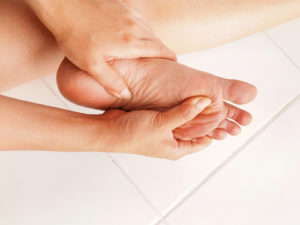 Are you struggling with strained Achilles tendons, hamstrings or calves? Have your foot muscles become weak lately? If you’ve experienced any of these symptoms than you may have Plantar Fasciitis. Plantar fasciitis is one of the most common causes of foot pain. Some activities that can lead a person to attain this ailment are certain sports that involve running, ballet dancing, aerobics, improper stretching and even poor walking mechanics. Let’s define Plantar Fasciitis right away so you can get an idea if this is the type of pain you might be dealing with. After that, we will let you know why we believe Treating the stubborn Plantar Fasciitis condition with Active Release Technique (ART®) Therapy is a great idea for several reasons.
Are you struggling with strained Achilles tendons, hamstrings or calves? Have your foot muscles become weak lately? If you’ve experienced any of these symptoms than you may have Plantar Fasciitis. Plantar fasciitis is one of the most common causes of foot pain. Some activities that can lead a person to attain this ailment are certain sports that involve running, ballet dancing, aerobics, improper stretching and even poor walking mechanics. Let’s define Plantar Fasciitis right away so you can get an idea if this is the type of pain you might be dealing with. After that, we will let you know why we believe Treating the stubborn Plantar Fasciitis condition with Active Release Technique (ART®) Therapy is a great idea for several reasons.
First things First…
Before we get into how Active Release Technique Therapy can help treat Plantar Fasciitis, let us explain what Plantar Fasciitis is and how you probably acquired this painful ailment. Plantar Fasciitis is an extremely painful condition caused by inflammation and swelling of the plantar fascia, a thick band of tissue that begins at the back of your heel, runs across the underside of your foot. It often is caused by overuse, poor natural mechanics, excessive body weight, sports or improper footwear.
There are many factors contributing to one’s Plantar Fasciitis and the one that stands out the most is the presentation of abnormal biomechanics in the joints of the foot, knee and or hip. Breakdown of normal joint motion in any one of these areas can alter your gait movement leading to increased stress on the soft tissues in the plantar surface.
Digging Deeper into Active Release Technique Therapy
The Mayo clinic describes Plantar Fasciitis as such: “Plantar fasciitis typically causes a stabbing pain in the bottom of your foot near the heel. The pain is usually the worst with the first few steps after awakening, although it can also be triggered by long periods of standing or rising from sitting. The pain is usually worse after exercise, not during it.” Plantar fasciitis can become a chronic injury, often termed plantar fasciosis at this point because there is minimal inflammation. Plantar fasciosis is often characterized by extensive scar tissue that restricts movement due to loss of blood flow to the area.
How can ART® help?
To fix plantar fasciitis requires a comprehensive analysis of the positions of the bones of the foot and a plan to restore their position. In addition, strengthening of the misfiring & atrophied muscles is required. Through a combination of manual therapy and a corrective exercise plan we can restore normal foot mechanics and spare the plantar fascia from absorbing excess energy. This is where we believe Active Release Technique therapy can be helpful in the recovery from Plantar Fasciitis.
ART® is a type of therapy that will treat your Plantar Fasciitis with the focus being, to locate and treat the scar tissues adhesions accumulated in the muscles and soft tissues. Treating Plantar Fasciitis through Active Release Technique will aid in the disruption breakdown of the adhesions while increasing the normal tissue flexibility, movement and comfort, and will be designed to restore your full flexibility, balance and stability.
In the end…
Using Active Release Technique to treat Plantar Fasciitis you will begin to see long lasting and immediate results. ART® will also break the cycle to continuous stress injuries and will help restore strength, speed and endurance. ART® can also help return your injury or ailment to it’s proper range of motion and help you to get back to optimal athletic performance. At the end of the day, Plantar Fasciitis isn’t an ailment that will be treated without pain. We want you to know that when it comes to the treating of your Plantar Fasciitis through Active Release Technique therapy, there will be a certain level of pain you will face. Rest assured, we will keep an eye on what tolerance you have and will not exceed that. For your recovery, should be a satisfying one, not an overall excruciating one.